The arrangement of a private house heating system is one of the main stages of construction or repair in a private house. Effective heating will create not only comfortable conditions for living, but also will be able to significantly save energy resources, which is very important at a constantly growing price of fuel. To create a heating system, you can invite masters, however, such services will cost quite expensive. With certain knowledge, skills and tools, this work can be done yourself. About how to make a heating system with your own hands, let's tell further.
Content
- How to choose a heating system for a private house. Varieties of heating systems
- Features of the steam heating of a private house
- Benefits of electric home heating
- Features of the air heating of a private house
- How to calculate a private home heating system
- Heating System Installation Procedure: Instruction
- Features of the installation of a private house heating do it yourself
- Features of the installation of a private house heating do it yourself
How to choose a heating system for a private house. Varieties of heating systems
If earlier the heating of the house was reduced to installing a wood-burning furnace, then in our time you can choose one of many types of heating systems. All of them are distinguished both by the type of generation and the number of components. By type of heat generation, heating can be:
- Gas. Gas boilers or gas convectors are used as heat recording in gas heating systems.
- Electric. To generate heat in electrical systems, electric boilers are used, fan heaters, infrared emitters, convectors.
- Solid fuel. Such systems as fuel use coal, firewood, peat, pellets. A solid fuel boilers, fireplaces, furnaces are used as a heat transfer.
By its functionality, the heating devices are:
- Single-mounted. Such devices work only on ensuring the warmth of the premises. The advantage of these boilers is a simple design and a relatively low price.
- Double-circuit. Such gas boilers can, in addition to heating, provide hot water tenants. These devices are more complex, and are more expensive, however, won due to its compactness. Basically, two-circuit boilers operating on gas and electricity are produced.
Selecting the type of heating system, first of all, depends on the availability of resources located in your region.
To install heating on natural gas, a sufficient diameter water supply should be supplied to the house to provide a boiler or convector with the desired amount of gas with a certain pressure. Use natural gas for heating is very careful, otherwise it can turn into a tragedy. Gas devices, in contrast to solid fuel, are characterized by a high degree of automation. Modern boilers can regulate the intensity of combustion of fuel depending on the temperature in the house.
To mount electrical installation, a force cable is needed to a house that would provide a sufficient current to operate the system.
In regions where there is enough forest, it is advisable to install solid fuel boilers working on firewood.
Features of the steam heating of a private house
In steam heating as a coolant, water is used, which has a very good heat capacity. It is heated in the boiler, with the help of the pump circulates through the system and gives heat air through radiators. This system consists of the following elements:
- Boiler (gas, electric, solid fuel, liquid, combined).
- Pump (can be built into the boiler or separately mounted).
- Tank expander. When boiling water and the formation of steam, its volume increases, and the tank serves to relieve excess.
- Radiators. We need to transfer heat from the coolant.
The disadvantages of this system is that it is impossible to be installed in non-permanently heated rooms. With severe frost, water from the pipeline will need to merge. Otherwise, water that is expanding when freezing can break the pipes and radiators.
Distinguish several types of systems:
- One-tube (sequential). Features of a single-tube heating system include the presence of only one heat supply circuit in which radiators are set sequentially (the output of one radiator is connected to the input of another). This type of steam heating is characterized by its simplicity and low cost. The disadvantage is the impossibility of adjusting heat supply in a separate room, and the last radiator in the chain will not give a normal amount of heat. Therefore, such systems are extremely rare.
- What is characterized by a two-pipe heating system? It provides 2 contours - feed and return. Each radiator in the system connects to the feed loop and to the loop contour. In this case, heat is given to them more evenly. If necessary, one of the rooms in the house can be turned off from heat supply or limit it. In the case of repairing one of the radiators, it will not be necessary to turn off the entire system, which facilitates the process of maintenance. This option is the most optimal for installation in a single-storey building.
- Multi-mounted system. Installed in large multi-level houses. For its installation, a thermal collector is used. This device adjusts heat supply to several contours that can be divorced throughout the house. Using collectors to one circuit, you can install radiators, and on the other - a warm floor. These systems are very convenient in terms of heat supply control, however, it is very expensive.
Benefits of electric home heating
Electric heating of a private house is not as popular as the use of gas, but recently the number of houses with such a type of heating systems is steadily growing. Over the past few years, electric boilers and convectors have made a big step forward. They have become much more economical, do not burn oxygen, do not require high currents when working.
When using convectors, the installation of the heating system is substantially simplified. Convector just attach to the wall and connect to the outlet. Modern models can even program for certain conditions. Such a device can independently turn on at a certain time, which will save funds due to the night tariff, as well as adjust the power depending on the specified room temperature. In addition, convectors can be installed in those houses where people accommodation is not constant. It does not need to be afraid that the system can know during the winter idle time.
Recently, electric ceramic heaters appeared on the market. They are distinguished by moderate consumption of electricity, more smooth heating of the room. Also, these models are not overpowered by air, which is very important for their use in residential premises.
Features of the air heating of a private house
The heat carrier in the heating system may not only be water, but also air. In such a heating, a boiler, a wood-burning furnace or an electric heater appears as a heat generator. The heated air enters the room along the air duct system or forcibly with the help of a supercharger or naturally by means of convection. In warm latitudes, where winter temperatures do not fall below + 5⁰s, it is advisable to use air conditioners to use air heating. They are much more efficient, since 1 Gcal of heat spend almost twice as smoking electricity than ordinary fan heaters.
The advantages of air heating are:
- Pretty high efficiency.
- The ability to parallel with heating air to clean it and remove unpleasant odors.
- The ability to adjust air humidity when using special humidifiers.
- Easy installation of air heating, thanks to which it is much cheaper than water or steam.
- The ability to turn off in the winter with a long lack of hosts in the house, without fearing the fact that the system will freeze.
- The possibility of connecting the air conditioner for air cooling in summer.
The disadvantages of the air cooling system are:
- Increased noise level with improper air blower.
- The possibility of mounting only at the stage of construction or overhaul.
- Fire hazard. In the event of a fire on the system of air ducts can quickly spread the flame or ditch gas.
- The need for proper placement of ventilation gratings. They should not be in places where people are long arrived.
How to calculate a private home heating system
When calculating the heating system, the main parameter is the area of \u200b\u200bthe premises that will be heated. In practice, all the premises should be heated in a private house, at least one wall of which goes outside.
The capacity of the boiler is calculated by the formula:
- W \u003d s * k / 10 * 1.15, where:
- W - boiler power.
- S is the area of \u200b\u200bheated premises.
- K - coefficient of climatic conditions. This indicator is calculated for each region and is a constant value. For example, for the southern regions, the coefficient is 0.7-0.95, and for the northern - 1.6-2.
- 1.15 - Recommended reserve of boiler power.
Thus, for the house, which is located in northern latitude, with an area of \u200b\u200bheated premises 100 m 2The recommended boiler power should be:
- 100 * 1.6 * 1,15 / 10 \u003d 18.5 kW.
Now for each room, the radiator power is calculated (number of sections). To do this, you need to know the area of \u200b\u200bheated room and the thermal power of each section of the radiator.
The number of sections is calculated by the formula:
- K \u003d S * 100 / W, where:
- S is the area of \u200b\u200bheated premises.
- W is the power of one section. For each type of radiator, it is different and depends on the surface area of \u200b\u200bthe section, as well as the material from which the radiator is made. The average power of the standard steel radiator is 200 W per section. Then for the room 20 m 2 The number of steel sections should be - 20 * 100/200 \u003d 10 sections.
Heating System Installation Procedure: Instruction
Consider the order of installation of the heating system. TaK, the first thing you need to install the boiler. Requirements for installing boilers are described in the manual manufacturer. But there are general rules:
- For heat generators with a capacity of up to 60 kW, installation in the kitchen is possible. For more powerful models, a separate boiler room is required.
- The floor boiler must have a free space in front of the front part of at least 1 meter. If the service from the side parts is not provided, the distance from the walls of the boiler to the walls should be at least 0.7 m, if the maintenance is needed - 1.5 m.
- When installing several boilers, the distance between it should be at least 1 meter. Between the front parts - at least 2 meters.
- Wall boilers are hanging at the lowest distance from the chimney. The perfect option when the boiler nozzle coincides with the chimney axis.
- Many modern wall boilers are equipped with a circulating pump and an expansion tank, so it is not necessary to install them separately.
Order of work:
- The first thing the boiler connects to the water supply. A bouncing crane is installed before connecting the pipeline and boiler.
- The feed loop is connected. After the boiler, a security group is mounted. A locking crane is also installed at the outlet of the contour from the boiler.
- The coolant feed is connected by the upper holes of the radiator. On radiators, adjustment valves are mounted.
- The lower opposite hole of the radiator is connected to the opposite contour. The filter and shut-off crane is installed on the return on the return to the boiler.
- In the absence of a membrane expansion tank in the boiler, it is installed on the return circuit.
- The next step towards the boiler is connected by the contour of hot water supply.
- Next, the system is filled with water and is driven to the detection of leaks. If the leaks are not detected, the gas hose is connected to the boiler.
- The recent step of the boiler connects to the power grid and its performance is checked under load.
Features of the installation of a private house heating do it yourself
When installing the heating system of the private house, you need to follow certain rules that will help make it more efficient:
- Heating radiators must be placed only under the windows. In this case, effective convection will be provided.
- The water system should have a drain at the lowest point preferably next to the sewer so that the coolant can be removed for repair.
- Battery ribs should be located just vertically.
- The distance from the bottom of the radiator to the floor should be at least 100 mm.
- The distance from the top of the radiator to the bottom of the window sill should be at least 60 mm.
- After the installation is completed, the system must be filled with water and check for the presence of leaks without turning on the boiler. If there are the flows of the connection, it is necessary to quit or remake.

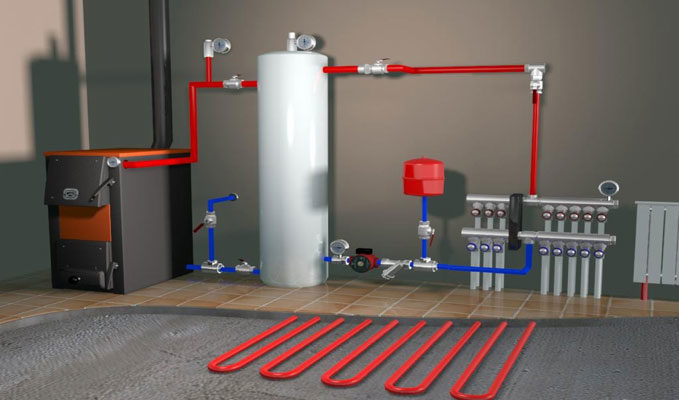

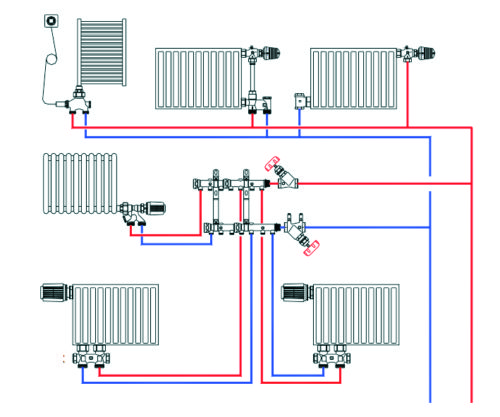
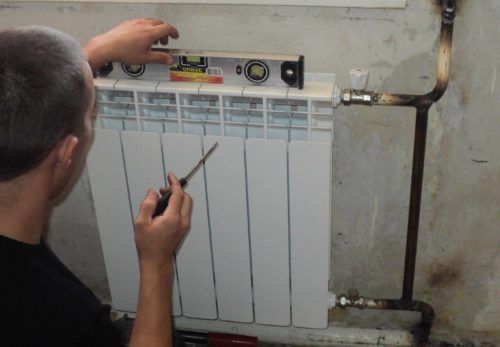


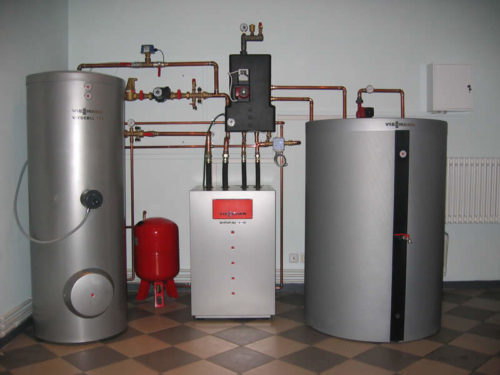
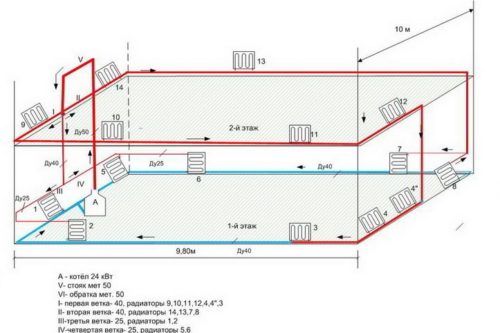
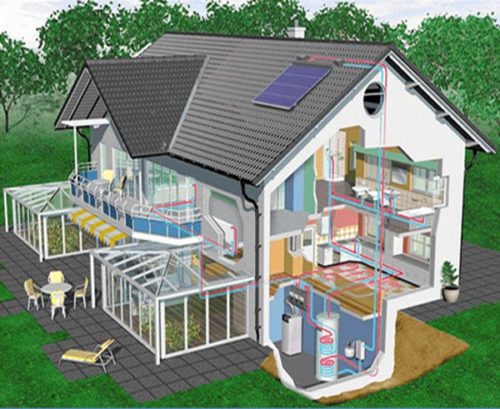
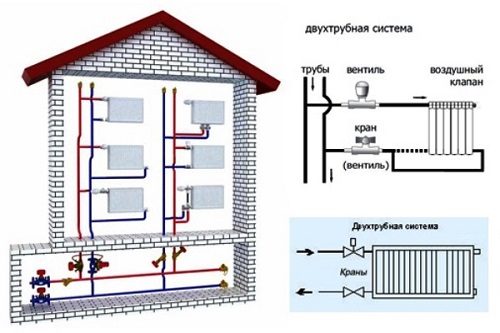
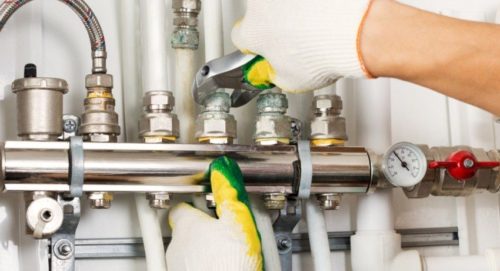


















It is better to think about it at once during construction, even when developing a project. I also chose not soaring, and already a proven and repeatedly built project ordered. He took at the Terem, they have a very good choice. And they also ordered heating. Made well. The house is though frame, but -15 holds without problems, in the house +18 stable, and without drafts. This is a high-quality construction and gasket heating.